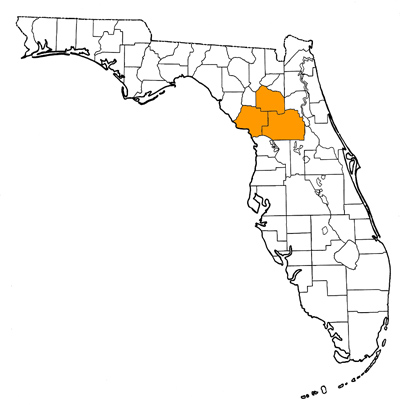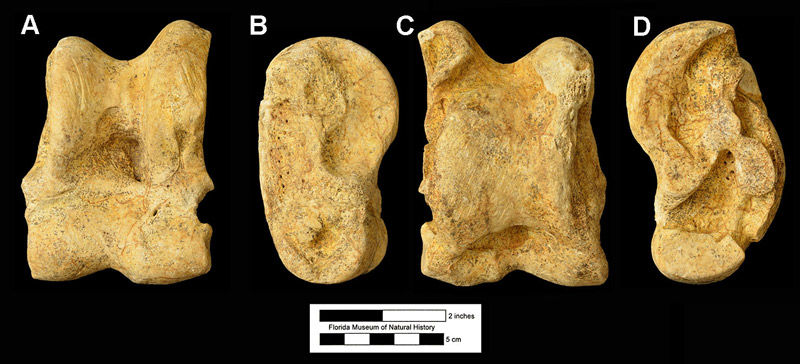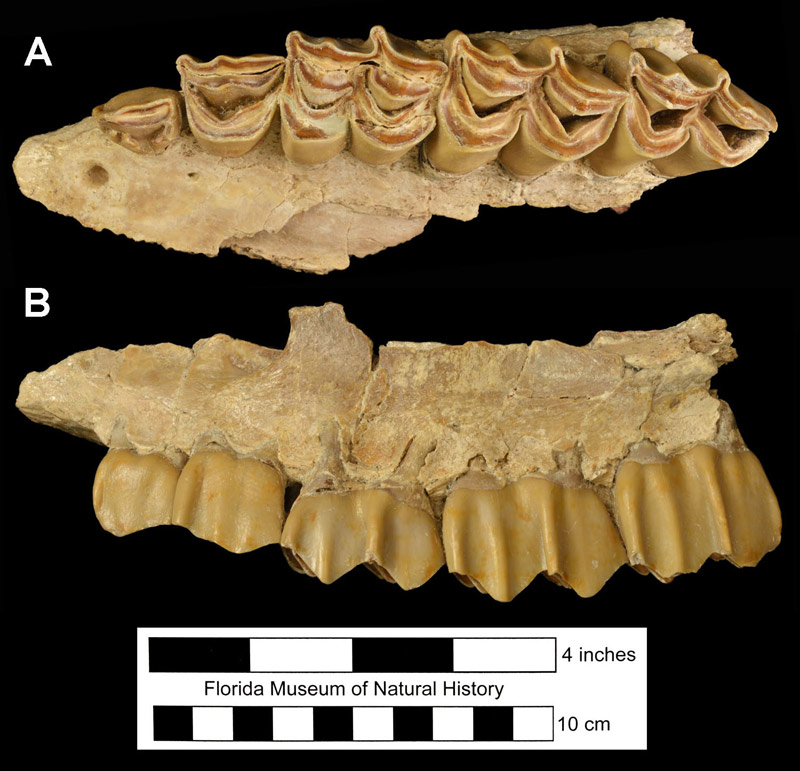Aepycamelus major
Quick Facts
Common Name: Leidy’s giraffe camel
The giraffe camels of the Miocene of North America and the true giraffes of Africa represent a great example of convergent evolution.
It had an estimated shoulder height of at least 13 feet, plus an additional 5 to 6 feet for the neck, which makes it likely Florida’s tallest land mammal.
Age Range
- Late Miocene Epoch; late Clarendonian to early Hemphillian (Cl4-Hh2) land mammal ages
- About 9.5 to 6 million years ago
Scientific Name and Classification
Aepycamelus major (Leidy, 1886)
Source of Species Name: Leidy (1886) did not explicitly state the origin of the name, but it is clear that he applied this name to the largest of the three species of camelid at the type locality, which he only distinguished by size (in the initial description). So the name presumably refers to the large size of this species.
Classification: Mammalia, Eutheria, Laurasiatheria, Artiodactyla, Tylopoda, Camelidae, Camelinae, Lamini
Alternate Scientific Names: Auchenia major; Procamelus major; Megatylopus major
Overall Geographic Range

Definitively known only from north-central Florida; Honey et al. (1998) also indicated its presence in Nebraska, but that record has yet to be published in detail. The type locality is Mixson’s Bone Bed, Levy County, Florida (Leidy, 1886).
Florida Fossil Occurrences
Florida fossil sites with Aepycamelus major:
- Alachua County—Haile 16C; Love Site; Tyner Farm
- Levy County—Mixson’s Bone Bed
- Marion County—Crystal Springs Mobil Home Park; Emathla; Withlacoochee River 5E
Discussion
The giraffe camels of the Miocene of North America and the true giraffes of Africa represent a great example of convergent evolution. In both, the ability to browse in the canopy of trees was attained by greatly increased limb and neck length. Aepycamelus major was the last and largest of the North American giraffe camels, with an estimated shoulder height of at least 13 feet (4 meters) plus an additional 5 to 6 feet (ca. 2 meters) for the neck (Webb et al. 1981). In terms of height, the species was likely the tallest land mammal known from Florida, possibly eclipsed only by the largest individuals of the giant ground sloth Eremotherium when they took on a bipedal stance. Based on the circumference of the humerus, MacFadden and Hulbert (1990) were able to use regression analysis to estimate the mass of Aepycamelus major at slightly more than 1000 kilograms (2200 pounds). Giraffe camels were widely distributed in North America in the middle Miocene, with records ranging from California to Nebraska and the Gulf Coastal Plain. Towards the end of the Miocene, the group was apparently limited to Florida (and perhaps other areas of the east that lack a fossil record).

That Leidy’s species was a member of the giraffe camel group was not immediately apparent, as the specimens collected at Mixson’s Bone Bed in the late 1800s consisted mostly of foot bones and isolated teeth, with no complete major limb elements or cervical vertebrae (Leidy and Lucas, 1896). The species was transferred to the genus Procamelus by Lucas in the preface to Leidy and Lucas (1896), where it remained for about 35 years. Simpson (1930) suggested that it might belong with the genus Megatylopus instead, and it remained in that genus for about 50 years (e.g., Webb, 1965). The Love Site produced the first complete metacarpal (with a length of about 34 inches or 87 cm) and cervical vertebra of the species, whose extreme lengths clearly showed that it was a giraffe camel. Therefore, Webb et al. (1981) referred the species to the genus Aepycamelus, where it has remained until the present time (e.g., Harrison, 1985; Honey et al., 1998). A complete metatarsal of Aepycamelus major from Tyner Farm has a length of about 24 inches (60 cm), while a cervical vertebra is 13 inches (34 cm) long.

The relative abundances of the three late Miocene camelids at Florida fossil localities varies greatly, and may reflect differences in habitat or environment when the sites formed. Aepycamelus major is rare at the Love Site and absent at McGehee Farm, Haile 19A, Moss Acres Racetrack Site, and Withlacoochee River 4A. But it is the most common camelid at Mixson’s Bone Bed, Haile 16C, Emathla, and Crystal Springs Mobil Home Park. At Tyner Farm, it is a close second in terms of abundance to the smallest of the late Miocene Florida camelids, Hemiauchenia minima.
Sources
- Original Author(s): Richard C. Hulbert Jr.
- Original Completion Date: October 1, 2013
- Editor(s) Name(s): Richard C. Hulbert Jr.
- Last Updated On: December 16 2020
This material is based upon work supported by the National Science Foundation under Grant Number CSBR 1203222, Jonathan Bloch, Principal Investigator. Any opinions, findings, and conclusions or recommendations expressed in this material are those of the author(s) and do not necessarily reflect the views of the National Science Foundation.
Copyright © Florida Museum of Natural History, University of Florida